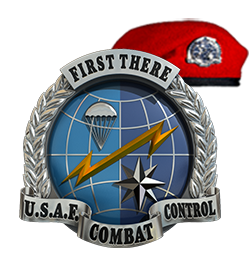Combat Control
School Training
The Air Force Special Operations Command
USAF Combat Controllers (CCT)
The Air Force has a little known group of elite airmen known as combat controllers. These battlefield airmen, who are also certified FAA air traffic controllers, play a vital role in the current operations taking place in Afghanistan, and in other directions actions and in providing humanitarian relief for disasters around the globe.
What Does a Combat Controller Do? As a service member under the U. S. Air Force Special Operations Command, a combat controller must be ready for anything. From being capable of operating in hostile environments, directing air traffic, relaying battle relevant information to pilots and military leaders, and in providing humanitarian relief to citizens in disaster zones
Prospective Recruits
The U. S. Air Force does not give just anyone a chance to be a combat controller. There are requirements and standards that must be met before a recruit gets a chance to see even the first stage of training.
Each applicant must be able to pass the Physical Abilities and Stamina Test consisting of swimming to demonstrate water competency, a timed run and variety of timed calisthenics, ensuring sufficient physical preparation for the entirety of Combat Control training pipeline.
The Road to Becoming Combat Controller
Once the prospective recruit has qualified and earned a training slot, the training really begins. Qualification begins with a 10-day Combat Control Screening Course at Lackland Air Force Base, Texas. This focuses on physical fitness and is used to 'weed out' any recruits who may not be suitable for further training.
After successful completion of the screening course, the trainees advance to the 16-week Combat Control Operator Course (official website) at Keesler Air Force Base, Mississippi. Here the trainee acquires a large volume of information such as how to recognize aircraft, air traffic rules, communication skills and radar skills.
The next stop is U.S. Army Airborne School for two weeks of static line jump training, and then it is on to Fairchild Air Force Base, Washington, for 17 days of survival school. As the name implies, this school teaches airmen the basic skills needed to survive in a remote and harsh environment.
The next training phase is the 13-week Combat Control School at Pope Air Force Base, North Carolina. This is where skills crucial to operating in a war zone are really developed. Such skills include land navigation, small unit tactics and field operations.
Follow-On Training
As a Combat Controller, the training never really stops. As soon as the title of Combat Controller is earned, it is on to more advanced training. This takes place over the course of a year while assigned to Hurlburt Field, Florida.
The Special Tactics Advanced Skills Training is broken down into three phases. During the five-month Formal Training Phase, combat controllers attend Air Force Combat Diver Course and Army Military Free Fall Course. These skills greatly expand the capabilities of the combat controllers, allowing them to be inserted from high altitudes by parachute, or by silent amphibious infiltration with diving equipment.
The three-month Core Phase allows the combat controllers to hone in their skills in communications, air traffic control and fire support with helicopters and fixed wing aircraft.
The final phase of the Special Tactics Training is the three-month Operational Readiness Training Phase. This is where the combat controller learns all the combat skills needed for future assignment to a deployable unit. This phase includes using tactical vehicles, conducting reconnaissance and learning skills needed to participate in a variety of combat operations.
Current Operations
After all of this training, the Combat Controller is ready to serve as a valuable battlefield asset. Due to a variety of acquired skills, combat controllers can operate with any deployed branch of the service.
They can be found in hostile areas of Afghanistan directing air traffic and fire support, while participating in direct action, reconnaissance and counter terrorism missions!
They have saved the lives of many U.S. and coalition service members by directing fire support to eliminate enemy combatants. At times they have done this while in direct engagement with hostiles forces and under fire.
The skills of U.S. Air Force Combat Controllers have been, and are still being battlefield tested.

